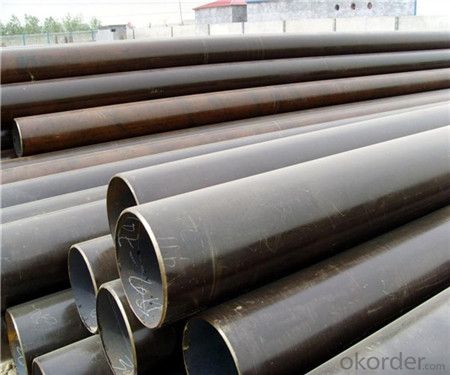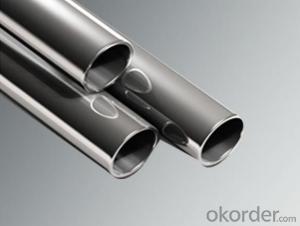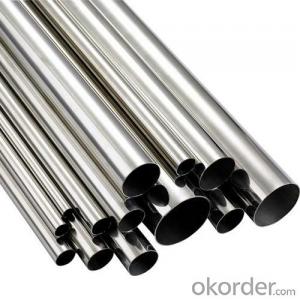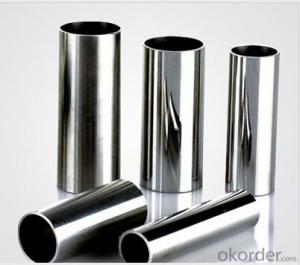Seamless Stainles Steel Pipe 304 china manufacturer
- Loading Port:
- China Main Port
- Payment Terms:
- TT or LC
- Min Order Qty:
- 30 m.t.
- Supply Capability:
- 12000 m.t./month
OKorder Service Pledge
OKorder Financial Service
You Might Also Like
1、Structure of Seamless Pipe ASTM A106/53:
carbon seamless steel pipes are widely used in gas, water and oil, transpotation;constructions;Bridge,highway,windows of model steel door; building materials;fences;heating facilities Fluid Pipe;conduit pipe,scaffolding pipe.etc.
Payment Terms: L/C D/A D/P T/T
standard:AISI, ASTM, GB, DIN
grade:300 series
size:(2-630) x (0.3-50) x (500 - 13000)mm
origin:Zhejiang
2、Main Features of the Seamless Pipe ASTM A106/53:
• High manufacturing accuracy
• High strength
• Small inertia resistance
• Strong heat dissipation ability
• Good visual effect
• Reasonable price
3、Seamless Pipe ASTM A106/53 Specification:
Standard | GB, DIN, ASTM ASTM A106-2006, ASTM A53-2007 |
Grade | 10#-45#, 16Mn 10#, 20#, 45#, 16Mn |
Thickness | 8 - 33 mm |
Section Shape | Round |
Outer Diameter | 133 - 219 mm |
Place of Origin | Shandong, China (Mainland) |
Secondary Or Not | Non-secondary |
Application | Hydraulic Pipe |
Technique | Cold Drawn |
Certification | API |
Surface Treatment | factory state or painted black |
Special Pipe | API Pipe |
Alloy Or Not | Non-alloy |
Length | 5-12M |
Outer Diameter | 21.3-610mm |
Grade | 20#, 45#, Q345, API J55, API K55, API L80, API N80, API P110, A53B |
Standard | ASME, ASTM |
4、Packaging & Delivery
Packaging Details: | seaworthy package,bundles wrapped with strong steel strip |
Delivery Detail: | 15-30days after received 30%TT |
5、FAQ of Seamless Pipe ASTM A106/53:
①How is the quality of your products?
Our products are manufactured strictly according to national and internaional standard, and we take a test
on every pipe before delivered out. If you want see our quality certifications and all kinds of testing report, please just ask us for it.
Guaranteed: If products’ quality don’t accord to discription as we give or the promise before you place order, we promise 100% refund.
②How about price?
Yes, we are factory and be able to give you lowest price below market one, and we have a policy that “ for saving time and absolutely honest business attitude, we quote as lowest as possible for any customer, and discount can be given according to quantity”,if you like bargain and factory price is not low enough as you think, just don’t waste your time.Please trust the quotation we would give you, it is professional one.
③Why should you chose us?
Chose happens because of quality, then price, We can give you both.Additionally, we can also offer professional products inquiry, products knowledge train(for agents), smooth goods delivery, exellent customer solution proposals.Our service formula: good quality+good price+good service=customer’s trust
SGS test is available, customer inspection before shipping is welcome, third party inspection is no problem.
6、Seamless Pipe ASTM A106/53 Images:
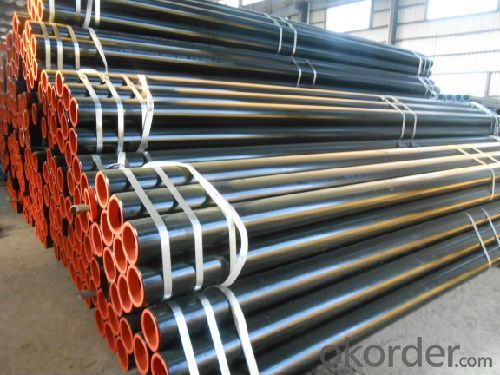


- Q: Can stainless steel pipes be used for steam transportation?
- Yes, stainless steel pipes can be used for steam transportation. Stainless steel has excellent corrosion resistance and high temperature strength, making it suitable for carrying steam under high pressure and temperature conditions. The smooth surface of stainless steel pipes also reduces friction and minimizes the risk of clogging or scaling, ensuring efficient and reliable steam transportation. Additionally, stainless steel is a durable material that can withstand extreme conditions, making it a preferred choice for steam transportation in various industries such as power generation, chemical processing, and oil and gas.
- Q: What are the different types of stainless steel pipe tees?
- There are several different types of stainless steel pipe tees, each designed for specific applications and requirements. 1. Equal Tee: This type of tee has three outlets of the same size, forming a 90-degree angle. It is commonly used to branch off or combine flow in a pipeline with equal diameters. 2. Reducing Tee: As the name suggests, a reducing tee has one outlet smaller than the other two. It is used to connect pipes of different sizes, allowing for a smooth transition in the flow of fluids or gases. 3. Barred Tee: This tee has a bar welded across the branch opening, providing additional support and reinforcement. It is commonly used in high-pressure or high-temperature applications to prevent stress concentration and potential failure. 4. Lateral Tee: A lateral tee has one outlet at a 45-degree angle, allowing for a branch connection at a different direction. It is often used in situations where a pipeline needs to be diverted or connected at an angle. 5. Cross Tee: A cross tee has four outlets forming a cross-shaped configuration. It is used when there is a need to split or combine flow in multiple directions, commonly found in complex piping systems. 6. Unions and Socket Weld Tee: These types of tees have sockets or unions at the branch connection, allowing for easy disassembly and maintenance. They are often used in applications where regular inspection, cleaning, or replacement is required. 7. Threaded Tee: Threaded tees have threaded branch connections, which can be screwed onto the pipe without the need for welding. They are commonly used in low-pressure applications or when frequent disassembly is required. Each type of stainless steel pipe tee offers specific advantages and is selected based on the requirements of the particular piping system, such as flow rates, pressure, temperature, and compatibility with the fluids or gases being transported.
- Q: Can stainless steel pipes handle extreme weather conditions?
- Stainless steel pipes are renowned for their exceptional durability and ability to withstand the harshest weather conditions. They exhibit remarkable resistance to extreme temperatures, heavy rainfall, fierce winds, and even harsh chemicals, remaining corrosion-free and undeteriorated. The inherent qualities of stainless steel, including its superior strength, resistance to corrosion, and tolerance to heat, render it an optimal choice for outdoor applications and adverse weather circumstances. Stainless steel pipes effectively endure intense heat and cold, while effectively combating the detrimental effects of UV radiation and oxidation. These pipes find extensive use in industries encompassing oil and gas, chemical processing, construction, and marine applications, where they confront formidable environments. All in all, stainless steel pipes offer a dependable and enduring solution for handling the most severe weather conditions.
- Q: What is the difference between seamless and spiral welded stainless steel pipes?
- When comparing seamless and spiral welded stainless steel pipes, the key distinction lies in their manufacturing process and structural characteristics. Seamless stainless steel pipes are formed by piercing a solid billet or bar of stainless steel and then rolling it into a hollow shape. This method does not involve any welding and produces a smooth and seamless pipe. Seamless pipes are commonly utilized in high-pressure and high-temperature applications where strength and corrosion resistance are crucial. They are renowned for their uniformity, precision, and ability to withstand extreme conditions. In contrast, spiral welded stainless steel pipes are manufactured by continuously rolling and welding a coiled strip of stainless steel. The strip is shaped into a spiral and then welded along the seam. This process allows for the production of large diameter pipes and is more cost-effective compared to seamless pipes. Spiral welded pipes are frequently employed in low-pressure and low-temperature applications like water and gas transportation, as they are less resistant to internal pressure and have a rougher surface compared to seamless pipes. Regarding structural characteristics, seamless stainless steel pipes possess a more consistent and uniform wall thickness, resulting in enhanced strength and durability. They also exhibit better dimensional accuracy and smoother internal surfaces, reducing friction and improving flow efficiency. These qualities make seamless pipes suitable for industries such as oil and gas, petrochemicals, and power generation, where reliability and performance are of utmost importance. On the other hand, spiral welded stainless steel pipes have a varying wall thickness due to the welding process, which can result in a weaker pipe compared to seamless ones. However, spiral welded pipes have the advantage of being able to withstand higher external pressures and bending forces due to their spiral shape. They are also easier to manufacture and can be produced in longer lengths, reducing the need for additional joints and connections. In conclusion, the choice between seamless and spiral welded stainless steel pipes depends on the specific requirements of the application. Seamless pipes offer superior strength, precision, and corrosion resistance, making them suitable for high-pressure and high-temperature applications. On the other hand, spiral welded pipes are more cost-effective, can be produced in large diameters, and are suitable for low-pressure and low-temperature applications.
- Q: What is the maximum temperature that stainless steel pipes can withstand?
- The maximum temperature that stainless steel pipes can withstand depends on the grade of stainless steel used. Generally, stainless steel pipes can handle temperatures ranging from 1200 to 1600 degrees Fahrenheit (650 to 870 degrees Celsius), with some specialized grades able to withstand even higher temperatures.
- Q: Why does the 304 stainless steel pipe leak?
- This is the mechanism of pitting ion in neutral solution, such as the effect of chlorine ion on the surface of the passivation film, surface damage, and pitting, uneven part of the organization, the structure of the metal inclusions easily become a source of pittingOf course, there are many other forms of corrosion on austenitic stainless steel, such as crevice corrosion, stress corrosion, and so on.
- Q: Difference between stainless steel and steel pipe
- Steel pipe according to the production method can be divided into two categories: seamless steel pipe and pipe joints, pipe joints as welded steel pipe.1. seamless steel tube according to the production methods can be divided into: hot-rolled seamless pipe, cold drawn tube, precision steel tube, heat expansion tube, cold spinning tube and extrusion tube.Seamless steel tubes are made of high quality carbon or alloy steel. They are hot-rolled and cold-rolled (drawn).
- Q: Can stainless steel pipes be insulated with fiberglass?
- Yes, stainless steel pipes can be insulated with fiberglass.
- Q: Are stainless steel pipes resistant to high temperatures?
- Yes, stainless steel pipes are generally resistant to high temperatures. Stainless steel is specifically designed to withstand high heat and maintain its structural integrity at elevated temperatures. The high chromium content in stainless steel forms a protective oxide layer on the surface, which helps to prevent corrosion and maintain its strength and durability even in extreme temperature conditions. This makes stainless steel pipes suitable for various applications that involve high temperatures such as industrial furnaces, heat exchangers, and exhaust systems. However, it is important to note that the specific resistance to high temperatures may vary depending on the grade and alloy of stainless steel used. Therefore, it is crucial to select the appropriate grade of stainless steel based on the specific temperature requirements of the application.
- Q: Can stainless steel pipes be used for high-temperature applications?
- Yes, stainless steel pipes can be used for high-temperature applications. Stainless steel is known for its excellent heat resistance properties, making it suitable for various industries that require pipes to withstand high temperatures. The high chromium content in stainless steel helps it to form a protective layer of chromium oxide on the surface, which prevents oxidation and corrosion even at elevated temperatures. Additionally, stainless steel pipes have high strength, good mechanical properties, and are resistant to thermal expansion and contraction, making them ideal for high-temperature applications such as power generation, chemical processing, oil and gas, and many other industries.
Send your message to us
Seamless Stainles Steel Pipe 304 china manufacturer
- Loading Port:
- China Main Port
- Payment Terms:
- TT or LC
- Min Order Qty:
- 30 m.t.
- Supply Capability:
- 12000 m.t./month
OKorder Service Pledge
OKorder Financial Service
Similar products
Hot products
Hot Searches
Related keywords





